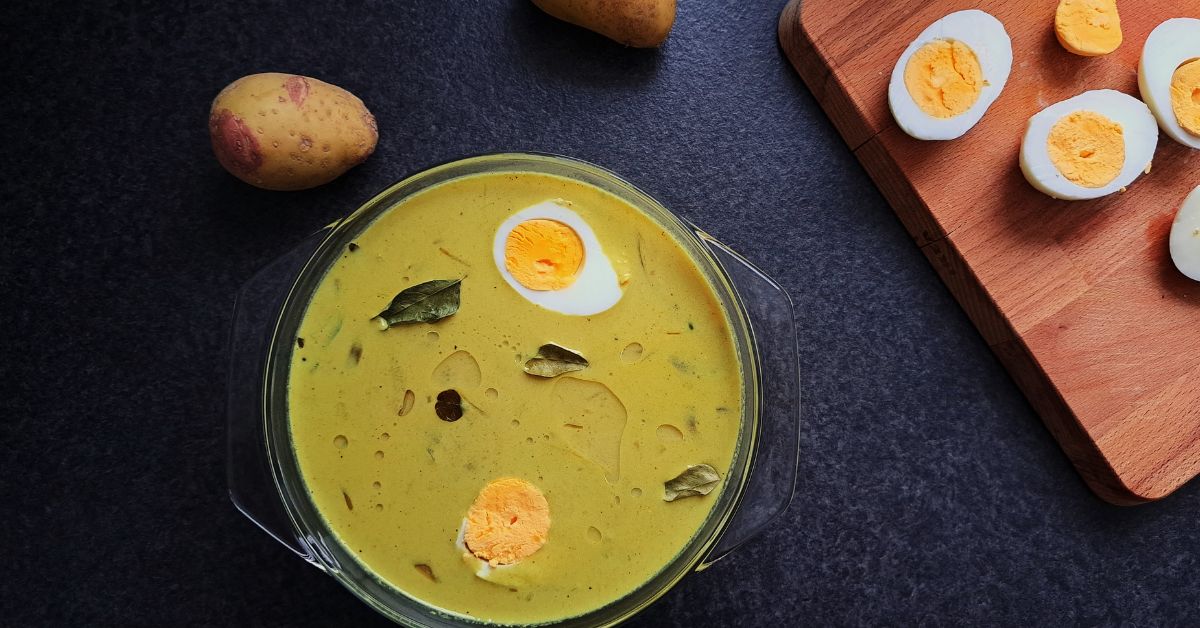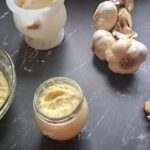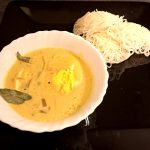Egg and potato curry for Appam, Idiyappam

Egg and potato Curry, a mouthwatering dish that perfectly complements the soft and spongy Appam, idiyappam. It is a South Indian delicacy celebrated in the states of Kerala and Tamil Nadu. This fusion of flavour and aromatic spices creates an experience that will take your taste buds to the vibrant streets of Kerala or Tamil Nadu. The boiled eggs and tender potatoes are bathed in a rich and flavourful coconut milk curry sauce.
Kerala and Tamil Nadu, nestled along the southwestern coast of India, share a profound love with the coconut. This versatile fruit plays an integral role in the cuisine, culture, and traditions. Coconut palms sway in abundance along the coastal landscapes, their bounty shaping the culinary traditions of these states for centuries. Ginger-garlic paste is another key ingredient in Indian cuisine and it enhances the flavour and aroma of dishes. Click here to learn how to prepare and store ginger-garlic paste.
Get ready to savour the delectable fusion of eggs, potatoes, and coconut-infused spices, that make South Indian cuisine a delight for the senses. Here’s a recipe for Egg and Potato Curry that pairs wonderfully with Appam, a popular South Indian dish.



Egg and potato curry for Appam, Idiyappam
Ingredients
- 4 hard-boiled eggs peeled and cut in half
- 2 medium-sized potatoes peeled and cubed
- 2 onions finely sliced
- 2 tsp ginger-garlic paste
- 1 cup thin coconut milk See notes
- ½ cup thick coconut milk See notes
- 2 tablespoons coconut oil
- 1 teaspoon mustard seeds
- 1 green chilly
- ¼ teaspoon turmeric powder
- 1 ½ tsp coriander powder
- 1 tsp pepper powder adjust to your spice preference
- 1 teaspoon garam masala
- Salt to taste
- A few curry leaves
Instructions
- Boil potato by adding a little salt in a pressure cooker for 4 whistles or in an open pan until tender. Keep it aside.
- Heat coconut oil in a deep pan or skillet. Add mustard seeds, curry leaves and green chilly. Allow them to splutter.
- Add chopped onions, salt and sauté until they turn translucent.
- Add the ginger-garlic paste and cook until the raw smell disappears.
- Add turmeric, coriander powder, pepper powder, garam masala and salt. Sauté for a couple of minutes.
- Add the cubed and boiled potatoes. Mash the potatoes a little to get a creamy texture.
- Pour in thin coconut milk. Mix well and let it come to a simmer.
- Add the thick coconut milk and allow it for 2 mins. Don´t boil after adding the thick coconut milk.
- Gently add the boiled, peeled eggs and simmer for another 2-3 minutes.
- Garnish with fresh curry leaves and a teaspoon of coconut oil.
- Serve the Egg and Potato Curry hot alongside the freshly made Appam, idiyappam for a delightful South Indian delight. Enjoy!
Notes
The other option is to use the coconut milk powder. Start by reading the instructions on the package of the coconut milk powder you have. Different brands may have slightly different instructions, so it’s important to follow the guidelines on the package. If you need thick coconut milk, use less water and more coconut milk powder; for thin coconut milk, use more water and less coconut milk powder. Alternatively, you can also prepare coconut milk at home. Here is the recipe: Coconut milk preparation:
You can prepare coconut milk at home using fresh coconut. Here’s how to make homemade coconut milk:
Add 1 freshly grated coconut in a blender and add some warm water (not boiling). The water should be warm, not hot, as hot water might change the taste of the coconut milk.
Blend the coconut and water mixture for a few minutes until it becomes a thick, creamy paste. You may need to do this in batches if you have a large quantity of coconut.
Strain the blended mixture through a fine mesh strainer or a cheesecloth into a bowl or container. Squeeze and press to extract as much liquid as possible. First Extract (Thick Coconut Milk): The first extract is the thick coconut milk, which is rich and creamy. Set aside the initial strained liquid. This is your first extract. Second Extract (Thin Coconut Milk): Add more warm water to the leftover coconut pulp in the blender. Blend again and strain as before. This is your second extract and is thinner than the first. Storage:
Transfer the coconut milk to a container and refrigerate it. It’s best to use it within a few days, but it can be frozen for longer storage.
Now you have fresh, homemade coconut milk ready to use in your recipes. The first extract is great for recipes that require a rich, creamy consistency, while the second extract is suitable for lighter dishes. Enjoy the pure, natural flavour of homemade coconut milk in your cooking.
